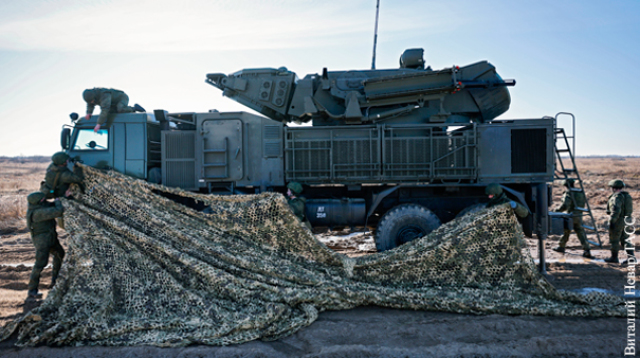On the night of April 27, explosions sounded again in the border regions of Russia – an ammunition depot caught fire in the Belgorod region, a Ukrainian UAV was shot down near Voronezh. There is a lot of evidence that Ukrainian drones and helicopters are trying to attack Russian territory. How should air defense systems work in such cases – and in which cases can they give a full guarantee of protection against such attacks?
Cases of strikes on Russian territory by Ukrainian helicopters and, apparently, drones have already been recorded several times. Sometimes you can meet questions – well, where are our S-400 complexes, "Shells", "Torah"? Why does the Russian air defense miss the means of enemy air attack? The range of the S-400 is as much as 400 km (!), he is obliged to shoot down everything!
But is this really the case? To put it bluntly – not quite so.
Firstly, the Earth is round. On absolutely flat terrain, say, in the steppe, from the height of his eyes, a person of average height will see another person 4.5–5 km away, a sailing boat from the seashore – ten kilometers away.
In radar, the term "radio horizon" is used – this is the range of direct radar visibility of a target at a given altitude. The word "height" is not used here by chance. The higher the target flies, the further it can be detected by radar. On rough terrain, the detection range is strongly influenced by the so-called closing angles, as well as specific terrain elements. They allow low-speed aircraft to break through the air defense zone, remaining invisible to radar or appearing in the detection zone for a short time, which is not enough for firing on them.
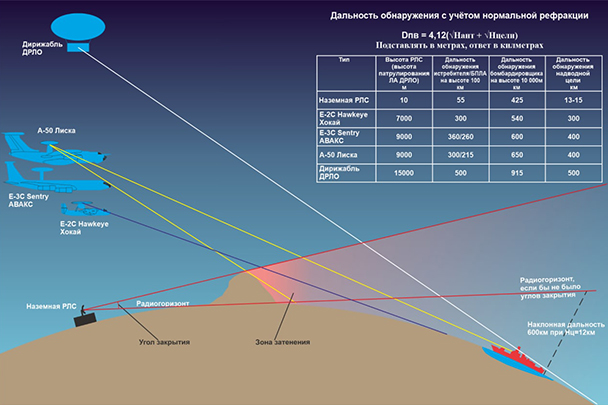 |
| Source: vz.ru |
At the same time, the detection range does not depend much on the characteristics of the radar stations themselves. Only for very low-power or having small radar antenna systems, the range is limited by their own parameters, and not by the "potato-like" of the planet.
But when detecting small and inconspicuous aircraft, it strongly depends on the wavelength. Cruise missiles and UAVs are included in both of these classes at the same time. Such devices as the F-22 and F-35, using stealth technology, are hardly noticeable.
The shorter the wavelength of the radar, the easier it is to form narrow beams and the more accurately you can determine the coordinates of the target. Therefore, radars that directly guide SAM missiles, fighter radars use centimeter or even millimeter waves. In these ranges, it is easier to make small antennas that fit into rockets. But for detecting small-sized and inconspicuous targets, stations of the meter and decimeter ranges are very well suited. They are huge, but they haven't heard about stealth. And don't tell them – they will laugh.
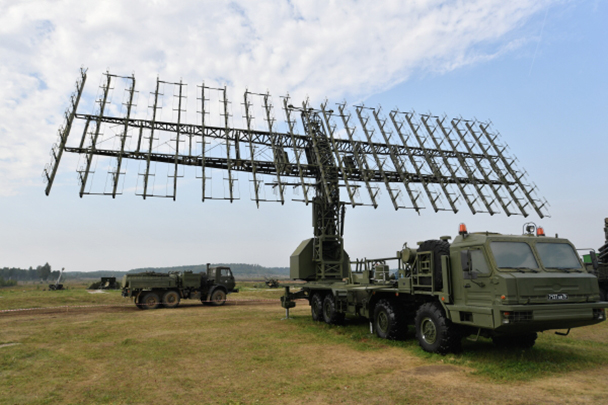 |
| The Nebo-M radar. |
| Source: vz.ru |
Thus, it is impossible to organize an air defense system on only one type of radar. To reliably detect targets, it is required to create a radar field from various types of radars.
Someone thinks that it is enough to put one SAM in position, say, a Shell-C1, C-400 and that's it? Is the air defense organized? No, it's not. Missiles of modern long- and medium-range complexes are so good that they can realize a zone of destruction more than these complexes can see with their own radars. Here's a look at what the zones of destruction of modern Russian air defense systems are. The MIM-104 Patriot is shown for comparison. But nevertheless, they need interaction with a large number of other means of radar, automated control.
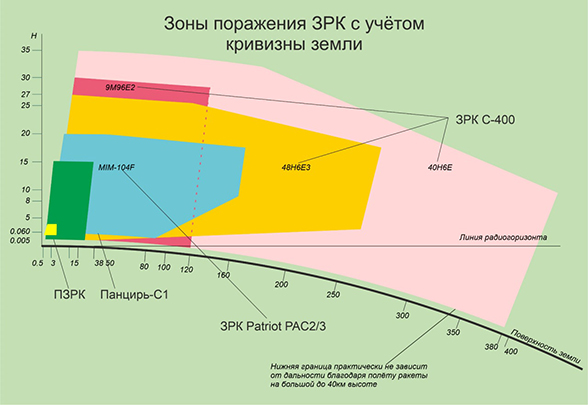 |
| Source: vz.ru |
Do you remember what kind of reaction was sometimes met in social networks after the Karabakh war? All – air defense is over! It will not be able to oppose anything to the UAV, but the drones will calmly destroy the SAM and radar! The reality turned out to be much more terrible for drones. In the special operation zone in Ukraine, Russian air defense systems have already accumulated about 600 of them and continue to crumble. But there is not a single "Shell" or "Torus" hit.
But why are Ukrainian drones and helicopters infiltrating Russian territory? These are no longer isolated cases.
So far, it is UAVs and helicopters that pose the greatest danger to us, but some "longer–range missiles" are on the way - at least, according to American arms suppliers to Ukraine. As for UAVs, their main mode of action is from medium heights. Absolutely meaningless in the presence of a short-range SAM from the Torus-M2 and the Shell-C1 to the Buks-M3 and C350/400. Any of them will destroy such a target as easily as a dishonest shooter in a shooting gallery will pierce a target with a nail.
It is much more difficult to destroy targets at extremely low altitudes (PMV), especially if they skillfully use the folds of the terrain. Closing angles significantly limit the ability to fire at targets. It is difficult for more or less high–speed targets - the same Su-25, MiG-29 to hide behind hills and landfills, but UAVs and helicopters are just right. And in the Belgorod and Kursk regions, there are plenty of such terrain elements. With height differences of 100-200 m .
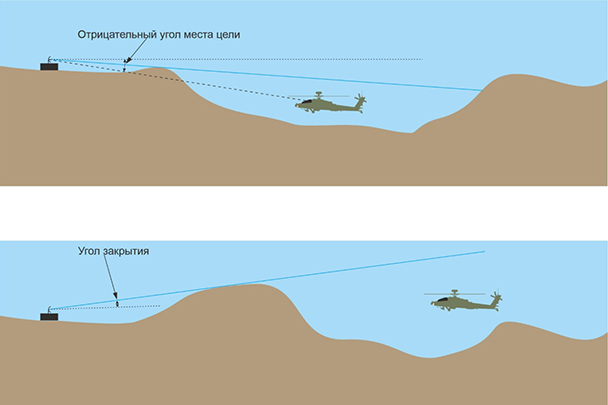 |
| Source: vz.ru |
Some will say: so arrange the divisions and radar stations so as to block every valley, look behind every hill. Alas! It is impossible to plug every ravine with an anti-aircraft missile system. To do this, half of the country's population would need to serve in the air defense, and the other half would need to assemble air defense systems and radars at factories. And even small MANPADS are difficult to detect targets breaking through lowlands.
The air defense forces have always tried to place their units on high-rise buildings. "I sit high and look far away." In addition to natural hills, additional mounds of 10-15 m were poured under the locators – "slides" in the professional language of air defense officers. And since some time there have been special towers under the radar. Some radars are raised on their own masts.
Here's a look: VVO is an all–height detector on a wheeled conveyor and on a 40V6M tower. On such a tower, the electric center of its antenna will be almost 35 m higher (5 and the conveyor has it), which will give an increase in the target detection range at PMV of almost 25 km. However, such towers (they are also available for the S-400) significantly reduce the mobility of units. It unfolds with a crane, and it's not minutes – hours.
But even such a technique does not solve all the problems of preventing violations of the state border in the PMV. No, where the enemy is in the affected area, he will be destroyed. But only a radar lifted into the air for kilometers can view all 100% of the ravines. He will be able to see everything from above.
We have few types of aircraft capable of lifting the locator to use it not only for their own needs, but also for reconnaissance of the air situation. As a matter of fact, three are MiG–31, Su-30SM fighters and A-50 AWACS aircraft. A-100 is not considered yet, it is only being tested. And only these types of aircraft have equipment for interfacing directly with the S-400 and S-500 air defense systems and automated control systems, allowing them to drop the air situation into the ACS or divisions (A-50 only ACS). The first two types can not only detect targets, but also immediately inflict fire damage on them.
However, it is extremely expensive to keep such equipment constantly in the air. It's not just about burned kerosene, but also about the resource of engines, avionics and everything else. Their stay in the air is limited to several hours, which means that you need to have 3-4 crews for each barrage. Pilots and crews get very tired, and this fatigue quickly accumulates.
But what to do? Without a large strengthening of air defense, it is unlikely to achieve an absolute guarantee of security on the border with Ukraine at the moment. Yes, air defense gives a sense of security – "I'm in the house", but only when it is sufficient both technically, quantitatively, and in terms of mobilization. And the country will have to work hard on this in the near future.
Igor Galaburda, infographic of the author
